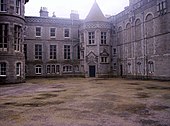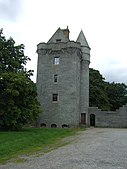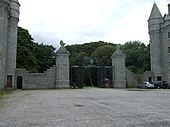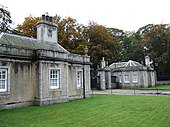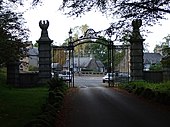Dunecht House
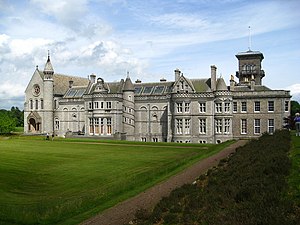
Dunecht House is a stately home on the Dunecht estate in Aberdeenshire, Scotland. The house is protected as a category A listed building,[1] and the grounds are included on the Inventory of Gardens and Designed Landscapes in Scotland, the national listing of significant gardens.[2]
History

The barony of Echt had been owned by the Forbes family since 1469 and the original mansion house, built in 1705, was known as Housedale. The present mansion is located slightly to the south-west of it.[3][4] In 1820 William Forbes commissioned the Aberdeen City Architect John Smith to design a replacement house in a basic two-storey Grecian-inspired style. The house and lands were sold to the 24th Earl of Crawford in 1845[5] for £117,000.[6] His main family residence was Haigh Hall in Greater Manchester and it was under the instruction of the 25th Earl of Crawford, his eldest son who succeeded him in 1869, that further extensive additions were made to the Dunecht mansion.[5][7] This phase of architectural work was undertaken by Smith's son William and spanned from 1855 to 1859.[8]
Usually an annual ball was held at either Haigh Hall or the family's London home but in October 1871 it was hosted at Dunecht. Attendees included the Gordons from Cluny Castle, the Abercrombies from Forglen House, the Irvines from Drum Castle and many other dignitaries from throughout the north-east.[9]
Additional internal renovations were commissioned around 1867 and undertaken by George Edmund Street.[1] A fire in early November 1872 caused some damage to the four-storey north-west wing which housed servant quarters.[10]
Alexander, 25th Earl of Crawford, died in 1880 and his body was stolen in 1881.[1] His body had been removed from a burial vault within the private chapel[11] but the removal of the body was not discovered until several months later after a note signed 'Nabob' was received. After extensive searches the body was eventually found on 18 July 1882 near a gravel pit close to the house.[12] The body was later transported to Haigh Hall and buried again in the family vault.[13]
The estate was offered for sale in 1886 but remained unsold[1] until purchased by A. C. Pirie in 1900.[14] Pirie added a new conservatory and dining room and also commissioned extra work on some of the estate buildings.[14] The mansion was leased to the 1st Viscount Cowdray and his wife, Annie, Viscountess Cowdray, in 1907. Lord Cowdray bought the estate in 1912, going on to commission further significant extensions until 1920. These were undertaken by Sir Aston Webb. Internal changes were undertaken to commence from 1924.[1] Lord Cowdray died in his sleep at the mansion on 1 May 1927 and is buried at Echt.[15] He was succeeded by his son, the 2nd Viscount Cowdray, who continued the internal renovations that were completed by c. 1932.[1]
It also has an observatory, built by the 26th Earl of Crawford[16] in 1872. Later, in 1888 he gifted his extensive library and all the observatory contents to the nation, on condition that the government build a new Royal Observatory, Edinburgh, rather than close it down following the resignation of then-Astronomer Royal for Scotland, Charles Piazzi Smyth.[17]
Architecture
The original design for the mansion by John Smith in 1820 was constructed from granite, had a full basement, three main reception rooms.[3]
Initial extensions designed by Smith's son built out to the west of the existing house. These incorporated a prominent Italianate tower in the style of Osborne House and canted bays on two gables. Large reception rooms were housed within these. The earlier part of the mansion had a new galleried staircase as well as other refurbishments made to it. A galleried staircase was added to the original part of the mansion and a porte-cochère in a Doric style graced the entrance.[5]
The mansion formerly had a large chime of eight bells by John Warner and Sons hung in its tower. However these were sold in 1996,[18] and since 1999, have served as the church bells of St Mary's, Haddington, in East Lothian.[19]
Gardens and wider estate
The Tower lodges and gates at Loch of Skene are also category A listed.[20] Several other structures within the estate are designated category B including the lodges.[21] The formal gardens are sited to the west and south of the mansion and feature two large terraces designed by Aston Webb in the early 20th-century.[8]
21st-century
The house was owned by Charles Anthony Pearson, brother of the 4th Viscount Cowdray,[citation needed] although it was unoccupied from 1998 while remaining in his ownership.[citation needed] It was marketed for sale in 2012[22] and purchased by Jamie Oag,[23] the owner of Spex Group and founder of Optima.[24]
Gallery
- The inner courtyard
- Memorial on the site of where the Earl's body was hidden
References
Citations
- ^ a b c d e f Historic Environment Scotland, "Dunecht House (Category A Listed Building) (LB3133)", retrieved 28 March 2019
- ^ Historic Environment Scotland, "Dunecht House (GDL00153)", retrieved 28 March 2019
- ^ a b Miller (2007), p. 82
- ^ Dunecht House, Housedale, Canmore, RCAHMS, archived from the original on 14 July 2014, retrieved 5 March 2014
- ^ a b c Miller (2007), p. 83
- ^ "Sale of Dunecht", Aberdeen Daily Journal, no. 17159, British Newspaper Archive, p. 4, 10 January 1910, retrieved 12 July 2014
- ^ Farrer, William; Brownbill, J, eds. (1911), "Haigh", A History of the County of Lancaster: Volume 4, British History Online, pp. 115–118, retrieved 22 March 2014
- ^ a b Dunecht House (PDF), Savills, archived from the original (PDF) on 3 March 2014, retrieved 22 March 2014
- ^ "Grand ball at Dunecht House", Aberdeen Journal, no. 6457, British Newspaper Archive, p. 6, 11 October 1871, retrieved 11 July 2014
- ^ "Fire at Dunecht House", Aberdeen Journal, no. 6513, British Newspaper Archive, p. 7, 6 November 1872, retrieved 11 July 2014
- ^ Tranter (1972), p. 68
- ^ Roughead (1913), p. 258
- ^ Roughead (1913), p. 259
- ^ a b Miller (2007), p. 84
- ^ "Lord Cowdray: Captain of great industry", The Times, 2 May 1927, retrieved 3 March 2014
- ^ Ashcroft, Tony (2009), Crowned with the stars, WLCT, retrieved 11 July 2014
- ^ Moran, K.; Brück, M. T. (2004), "The Crawford collection at the Royal Observatory Edinburgh", Journal of Astronomical Data, 10, Royal Observatory, Edinburgh: 47, Bibcode:2004JAD....10...47M, retrieved 11 July 2014
- ^ "St Mary's Parish Church - History_bells". www.stmaryskirk.co.uk. Retrieved 10 October 2020.
- ^ "The Keltek Trust - Works in Scotland" (PDF). Archived (PDF) from the original on 30 September 2020.
- ^ Historic Environment Scotland, "Tower Lodges and Gates and Loch of Skene Boathouse, Dunecht House (Category A Listed Building) (LB16505)", retrieved 28 March 2019
- ^ HS search results, retrieved 27 February 2014
- ^ Marketed 2012, retrieved 27 February 2014
- ^ "Millionaire former mechanic", Daily Record, 28 October 2012
- ^ Tyler, R. (15 September 2013), "Maths Men oust the Mad Men", Sunday Times, ISSN 0956-1382, ProQuest 1432386733(subscription required)
Bibliography
- Miller, David G. (2007), Tudor Johnny: City Architect of Aberdeen: The Life and Works of John Smith 1781–1852, Librario, ISBN 978-1-904440-97-0
- Roughead, William (1913), Twelve Scots Trials, W. Green & Sons
- Tranter, Nigel G. (1972), The eastern counties: Aberdeenshire, Angus and Kincardineshire, Hodder General Publishing Division, ISBN 978-0-340-16462-4


